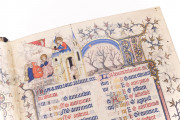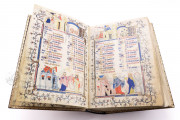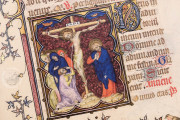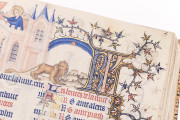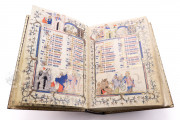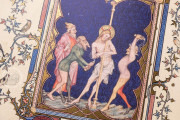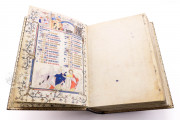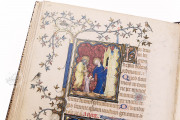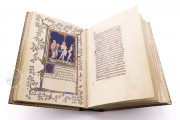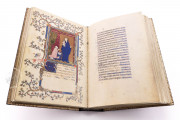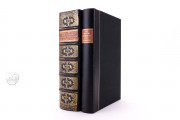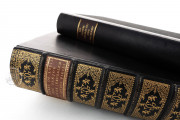On behalf of Jean de France, Duke of Berry, the foremost illuminators of the late fourteenth century crafted an extraordinary work of art. Its rich and delicate paintings earn it recognition by scholars and art historians as one of the most magnificent artifacts of the Late Middle Ages.
This lavish Book of Hours features both text and miniature pages intricately decorated with exquisite scrollwork, known as rinceaux, adorned with birds and butterflies. Few works of this genre boast such elaborate ornamentation and decoration.
Jean de France, Duke of Berry: A Collector and Great Patron of the Arts
Born in 1340, Berry was closely related to three French kings—his father, brother, and nephew. His family connections and position as a duke governing a significant portion of the French heartland placed him among the great princes of his time.
Berry's era was one of war, upheaval, and social unrest—France engaged in conflicts against England and was troubled by the Great Schism of the Church, as well as brutal civil wars. Although frequently involved in political matters, Berry's true interests lay elsewhere.
As a young man, Berry supported talented artists by providing inspiration, commissioning artworks, offering financial support, and being a passionate collector of paintings and esteemed bibliophile of the Middle Ages. His manuscript collection's artistic value far exceeded that of other princely courts of his time. He passed away on June 15, 1416, at the age of 75.
A Masterpiece for Many Generations
Around 1372, the Duke of Berry commissioned the Petites Heures, employing five illuminators for its decoration. While collaboration among artists was common then, these five miniaturists produced results unmatched by other embellished manuscripts of the era.
The illustrious Jean Le Noir initially oversaw the decoration. Dominating French book illumination since 1340, he remarkably continued creating artistic masterpieces even after 40 years. Following Jean Pucelle's renowned painting tradition, he crafted illustrations for the Passion of Christ, the Penitential Psalms, and scenes from the Office of John the Baptist, all displaying his unique composition style despite being completed by others.
After Jean Le Noir's death, work on the manuscript paused for several years. Later, Jacquemart of Hesdin and colleagues, including the Master of the Trinity and the so-called pseudo-Jacquemart, were commissioned to finish the work between 1385 and 1390. Around 1400, years after its completion, a miniature by one of the Limbourg brothers was added. This diversity in artistic contributions places the Petites Heures among the most significant works in late medieval book illumination, bridging the art of the French court from the late fourteenth century to the dawn of the International Gothic style.
Illustrations of Perfect Beauty in Record Numbers
Every leaf was carefully adorned, resulting in 119 miniatures. The fine illustrations were crafted as visual elements emphasizing the importance of the devotional texts, covering key aspects of Christian faith—from calendar miniatures and the life of the Virgin to the Passion of Christ and venerated saints' stories associated with the duke.
Lavish Decoration in Silver and Gold
The numerous images featuring the art patron himself make this manuscript a deeply personal creation. The duke was known to carry this Book of Hours on his extensive travels. Its opulent decoration required various motifs: lavish initials on nearly every page, stunning scrollwork, and countless birds and butterflies. The manuscript's miniature pages are ornately embellished with gold and silver, reflecting the unparalleled quality deemed fit for the duke's most cherished Book of Hours.
We have 1 facsimile edition of the manuscript "Petites Heures of the Duke of Berry": Petites Heures du Duc de Berry facsimile edition, published by Faksimile Verlag, 1989
Request Info / Price



